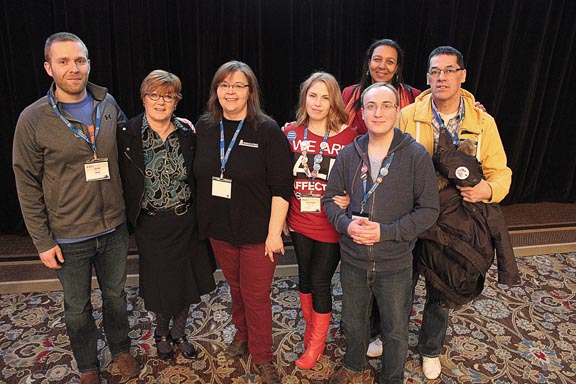Nearly 1,500 enthusiastic labour activists gathered in Toronto, Ontario from March 22-24, 2013 for the Canadian Labour Congress Political Action Conference.
This exciting conference was the largest conference the CLC has ever organized and the first National Political Action Conference in its history. Representatives from every one of the CLC’s 54 affiliates attended over 40 different workshops aimed at shaping political activists into political organizers.

DAY ONE
Thomas Walkom, national affairs columnist for the Toronto Star, and Tim Lyons, assistant general secretary of the Australian Council of Trade Unions spoke to delegates on the first day of the conference offering their insights and experiences.
“The organizers wanted me to scare you,” Walkom joked. “I can tell you that I’m scared, as a union member and a union supporter, because unions are under attack in a way that I don’t think we’ve seen since the 1930s in North America.”
Walkom discussed “right to work” laws, a term he rejects for being misleading and inaccurate. “Right to work laws don’t deal with the ‘right to work’, they deal with defunding unions. Maybe you could call them ‘freeloader encouragement’ laws, but they’re not ‘right to work’ laws.”
DAY TWO
Day two opened with remarks from CLC President Ken Georgetti who told the audience that, together, they would win the hearts and minds of the Canadian public. “Make a pledge that you’ll go back and do this for YOUR union, YOUR Labour Council, YOUR Federation of Labour and Labour Congress. Because if we stay strong, they can never, ever defeat us.”
As part of the plenary panel on “Reconnecting with our members”, Jan Schaffer, northeast regional campaign coordinator for the AFL-CIO, stressed the importance of member-to-member initiatives. “Member-to-member communication and member mobilization is the key to winning, getting our members mobilized and talking about these issues. It has to be strategic. We need to move members and their families to the front of these campaigns.”
Kevin Millsip of Next Up says the labour movement needs to employ the strategy of being “here to hear”. “People want to know that we give a damn about what they have to say,” he explained.
After an afternoon of engaging, hands-on workshops, delegates ended the day with a rousing speech from Tom Mulcair, leader of Canada’s New Democratic Party, the Official Opposition in the House of Commons.
“It’s important for me to see so many young people here today,” he told the crowd. “Of all the issues in our movement, none are more important than removing inequalities between generations.”
The comment was especially fitting given the special young workers’ forum prior to the commencement of the conference and the multitude of young worker focused workshops on the agenda.
DAY THREE
The better part of Sunday morning was reserved for a stimulating plenary panel on “Labour’s image, community and political engagement”.
“The rise of the middle class wouldn’t have been possible without the labour movement: workers standing together to improve our rights,” explained Trish Hennessy of the Canadian Centre for Policy Alternatives. “That’s why Harper thinks you’re dangerous, because he knows when workers work together, they have a lot of power. The labour movement has always been about the possibility of what we can do together. We cannot do it alone, but, together, anything is possible.”
After two more workshop sessions, the day and conference came to an end with closing remarks from Hassan Yussuff, secretary-treasurer of the Canadian Labour Congress.
“I still remain tremendously optimistic because if we intensify our political action, we can fundamentally change things in this country. It starts with you. Engage activists on the value of our unions and our collective agreements. We’re not interested in just making a statement, we’re here to win.”
